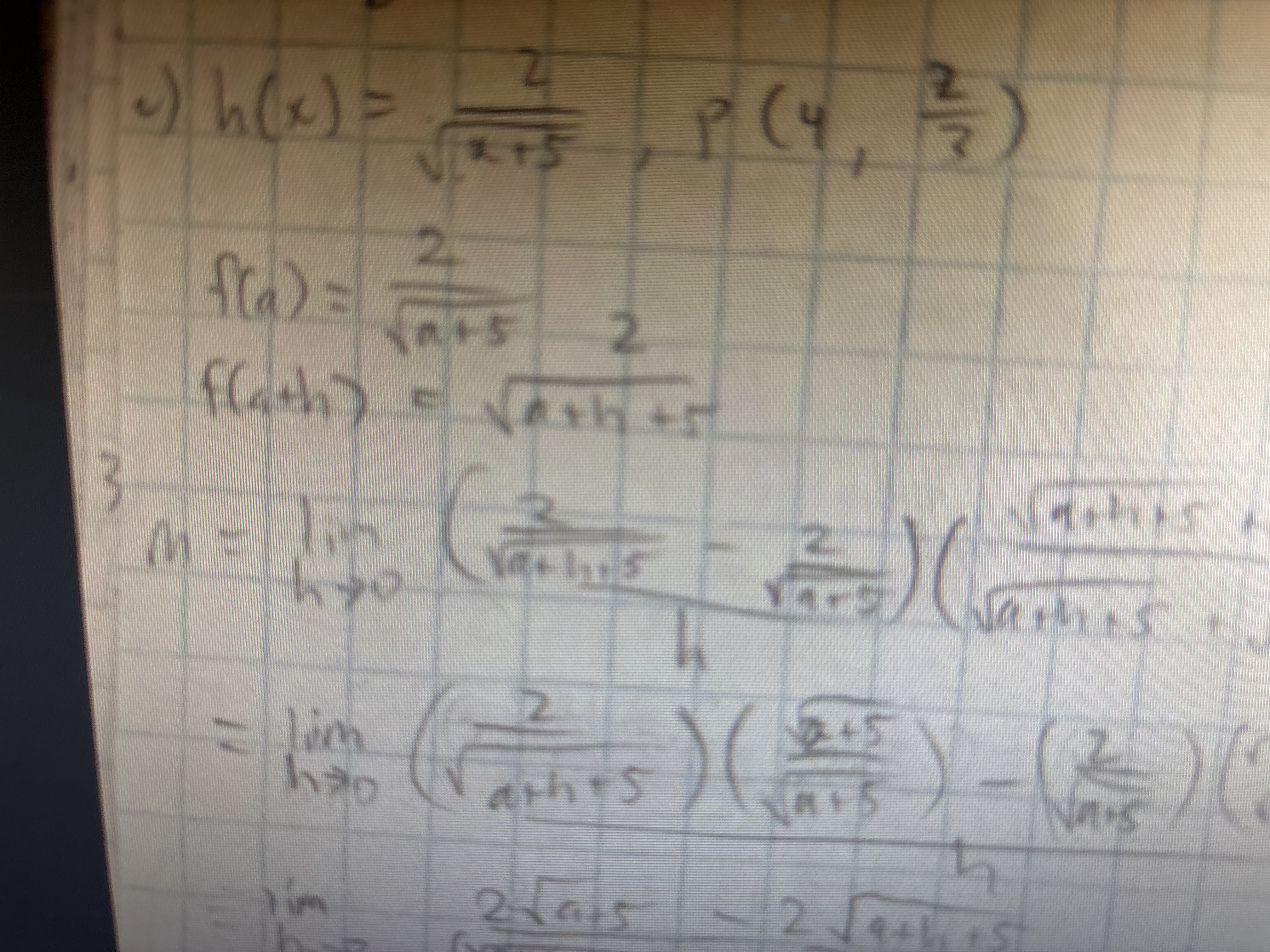Given h(x) = 2/√(x+5) and P(4, 2/3), find the slope of the tangent line at P using the limit definition of the derivative.

Understand the Problem
The question appears to be asking to find the slope of the tangent line to the function h(x) at the point P(4, 2/3) using the limit definition of the derivative. This involves evaluating the limit as h approaches 0 of the difference quotient [f(a+h) - f(a)]/h, where f(x) = 2/√(x+5) and a = 4. The image shows an attempt to simplify this limit.
Answer
$-\frac{1}{27}$
Answer for screen readers
$-\frac{1}{27}$
Steps to Solve
- Set up the limit definition of the derivative
The derivative of $h(x)$ at $x=a$ is given by: $$h'(a) = \lim_{h \to 0} \frac{h(a+h) - h(a)}{h}$$ In our case, $h(x) = \frac{2}{\sqrt{x+5}}$ and $a = 4$. Thus we want to evaluate $$h'(4) = \lim_{h \to 0} \frac{\frac{2}{\sqrt{4+h+5}} - \frac{2}{\sqrt{4+5}}}{h} = \lim_{h \to 0} \frac{\frac{2}{\sqrt{9+h}} - \frac{2}{\sqrt{9}}}{h} = \lim_{h \to 0} \frac{\frac{2}{\sqrt{9+h}} - \frac{2}{3}}{h}$$
- Simplify the expression inside the limit
Combine the fractions in the numerator: $$\frac{\frac{2}{\sqrt{9+h}} - \frac{2}{3}}{h} = \frac{\frac{6 - 2\sqrt{9+h}}{3\sqrt{9+h}}}{h} = \frac{6 - 2\sqrt{9+h}}{3h\sqrt{9+h}}$$
- Rationalize the numerator
Multiply the numerator and denominator by the conjugate of the numerator: $$\frac{6 - 2\sqrt{9+h}}{3h\sqrt{9+h}} \cdot \frac{6 + 2\sqrt{9+h}}{6 + 2\sqrt{9+h}} = \frac{36 - 4(9+h)}{3h\sqrt{9+h}(6 + 2\sqrt{9+h})} = \frac{36 - 36 - 4h}{3h\sqrt{9+h}(6 + 2\sqrt{9+h})} = \frac{-4h}{3h\sqrt{9+h}(6 + 2\sqrt{9+h})}$$
- Cancel out h and simplify
Cancel the $h$ term from the numerator and denominator: $$\frac{-4}{3\sqrt{9+h}(6 + 2\sqrt{9+h})}$$
- Evaluate the limit as h approaches 0
Now, take the limit as $h \to 0$: $$\lim_{h \to 0} \frac{-4}{3\sqrt{9+h}(6 + 2\sqrt{9+h})} = \frac{-4}{3\sqrt{9}(6 + 2\sqrt{9})} = \frac{-4}{3(3)(6 + 2(3))} = \frac{-4}{9(6+6)} = \frac{-4}{9(12)} = \frac{-4}{108} = -\frac{1}{27}$$
$-\frac{1}{27}$
More Information
The slope of the tangent line to $h(x) = \frac{2}{\sqrt{x+5}}$ at the point $P(4, \frac{2}{3})$ is $-\frac{1}{27}$. This means that at the point $(4, \frac{2}{3})$, the function $h(x)$ is decreasing with a rate of $\frac{1}{27}$.
Tips
A common mistake is not correctly rationalizing the numerator, leading to errors in simplification and the final result. Another common mistake is to incorrectly evaluate the limit by not substituting $h = 0$ after simplifying the expression. Also, algebraic errors in expanding and simplifying the expression are frequent.
AI-generated content may contain errors. Please verify critical information